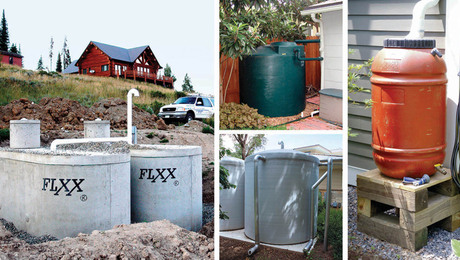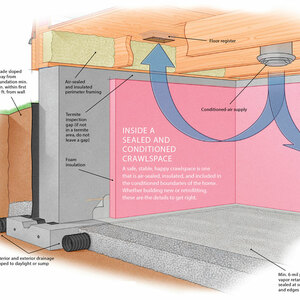My friend and i dug up her septic tank lids, one of which was over 3′ deep under a pile of boulders. I don’t want to do this ever ever ever again, so we asked the poop pumper people about adding a collar and they said they’d be happy to do that when they come out Friday to suction the tanks. However, they use only plastic collars instead of concrete rings, which is all i’ve ever had experience with on my own projects. I asked how the plastic collars are fastened to the tank and they told me they use the kind of spray foam used around windows.
I dunno…any reactions to this? I have until Friday to research. I’d like to think the plastic is fine because lowering concrete rings into a hole sounds like serious work to me at my advanced age, but will foam really hold it in place and and will the sides really not collapse when backfilled that deep?


















Replies
I looked into this before burying our tank. As it turns out I didn't need a collar, but from what I remember in a discussion with the tank and collar manufacturer:
- the real issue is whether the tank will collapse from the weight of the earth above. (Not so much when it is full, but when it is pumped there is no static pressure to hold it outward.) If this tank has been buried this way for years, there probably won't be a problem.
- the collar will mostly be held in place by the backfilled earth. The foam is just to steady it while backfilling and to stop fine particles from falling inside.
- 3 feet of fill over top was the limit for my tank. (plastic)
Scott.
Always remember those first immortal words that Adam said to Eve, “You’d better stand back, I don’t know how big this thing’s going to get.”
Edited 8/2/2006 12:44 am by Scott
I should confirm that this is a concrete tank, in a non-driving area, so a collapsing tank isn't the issue at all. On the plastic tanks, i thought the collars and tanks joined together, no? I'm worried the plastic riser on a concrete tank will either collapse or frost heave or any number of dark scenarios that would mean i would have to revisit this nasty job.
Ugh. I know what you mean. Perhaps the 'pumper people' could provide some references.
OTOH, it's important to remember that this is a fairly crude application. As I mentioned, I didn't need the 3' collar. Instead, I opted for a 2' deep box hastily built from PT lumber, plunked on top of an arched top tank, backfilled by hand, no foam.
Then I built an equally crude lid for said box. It's been quite stable for four years, and we do get frost (2' depth). I had the tank pumped last month which involved nothing more than flipping the lid off, brushing away about 10,000 spider webs, and lifting off the tank lid. There has been no problem with dirt entering the box.
Scott.Always remember those first immortal words that Adam said to Eve, “You’d better stand back, I don’t know how big this thing’s going to get.”
Splintergroupie-
No first hand experience, but I've seen some pretty amazing things made out of plastic. Remember car bumpers are mostly plastic now and they can take how many pounds of pressure at 5 mph?? I can imagine doing a ring out of one, heck of a lot easier to handle than concrete. I don't thik they would be selling these things if they weren't going to hold up. Sounds like a liability for them.
And what's this about "advanced age"? Stuff like this keeps you going. (G)
Don K.
EJG Homes Renovations - New Construction - Rentals
One of my husbands wore tie-dyed briefs to our nuptials. Just because a thing is done, even legally, does not make it a good idea.
SG-
Okay, so he had strange underwear... Was that a problem or a symptom of one?
Getting back to the issue of the sewer ring - why do you feel uncomfortabe with it? Is it because of the lateral pressure or the pressure from the top? Many cesspools were built out of individual concrete blocks which were just pushed together - no strength at all if you pushed on one, but because the pressure was exerted around the entire ring, they held for years. I would see a unified plastic ring as being stable.
As far as the pressure from the top, why not just ask the supplier for some literature showing how much pressure they can hold? I presume they are a supplier, not a manufacturer, so they should have some back up for their product - a website maybe?
Don K.
EJG Homes Renovations - New Construction - Rentals
"Getting back to the issue of the sewer ring - why do you feel uncomfortabe with it?"My original post said i was worried about the sides collapsing from backfill at that depth, so i thought the question was obvious, but the focus seems to have been lost while the question remains. Ah, well, i shall do some local calling now that the locals are awake, and see if a consensus develops. Thanks.
How 'bout you tell all us uneducated folks what you found?
Don K.
EJG Homes Renovations - New Construction - Rentals
Okey-Dokey.
I found out that unless someone needs to crawl down into the tank physically, e.g. to do repair work, the 24" diameter opening doesn't need to be used. I learned that what is more typical in my area is to use the smaller 8" lid that is inside the larger lid, attach an 8" PVC riser to it (spec'd as an "FDR-35", unless i want to pay a great deal more money for the matching cap, since there are three actual sizes of nominal 8" PVC pipe), and mortar it in. I can then extend the 8" riser above ground, or leave it below ground and covered with something like a sprinker valve box, or terminate it below ground with a hunk of metal over it that can be found with a metal detector. In any case, the pumper people and supply houses i spoke to (five of them) assured me there was no problem doing a good job of pumping out the tank from an 8" pipe compared to the 24" opening.
Edited 8/2/2006 6:36 pm ET by splintergroupie
"attach an 8" PVC riser to it (spec'd as an "FDR-35"Are you sure that it is not SDR-35.SDR is a standard way of specing pipe and there are other ratios than 35.SDR pipe have constant strength (pressure ratings) regardless of the diameter.Sch Pipe has a fixed wall thickness and get weaker for larger diameters.SDR-35 is a common pipe used for sewer and drain lines. But there is also a Sewer & Drain pipe (ASTM D-2729 IIRC) that is the same OD, but thiner walls.
FDR v. SDR..........Thank-you! I [mis]wrote it down as the young man on the phone was talking to me, but i confused the similar sounds. Thanks for explaining the differences so well and giving me "SDR" to google; i didn't realize it was different than the Sch. 80 i'd used for drain lines.
If you fill with a coarse gravel instead of dirt, the water will tend todrain away so there is no or very little water to freeze
use them all the time never had a problem.
For cost and ease, i think we'll go with the PVC riser i found out about today. I was still concerned about frost heaving, but i was told that the tank is warm enough that wouldn't be a problem, even for us Northerners. Thanks for the vote of confidence in the plastic.
plus the lids that screw in are real nice. keep it a foot below grade and seed right over.
Our riser tops have to be above grade...I've looked for ones like yours and understand why<G>Once its backfilled, the riser shouldn't be going any where...the waterproof seal between the the riser and the tank is a very convenient convenience...can be an extra holding tank in a jam...don't ask how I know this, and I won't try to shake you hand... I need a dump truck, baby, to unload my head
I have an old bag fo bentonite i was thinking i could toss around the mortar when i'm done fastening it in, but my idea was to keep ground water out instead of sewage in, though i can see it could work both ways. <G>
I chatted with the owner of these septic tanks tonight and she mentioned she thought they needed to terminate above grade from what she remembered talking with the sanitarian when she was trying to find out if the location of the tanks had been recorded, as they were supposed to have been by the guy who pulled the permit, but weren't. She's going to get the low-down on the code tomorrow and we'll go by that, and record the location this time, too.
One of the two tanks we are dealing with is in a horse pasture, so that one would require something to prevent one of the big lugs from stepping in it. I'm thinking a protective ring of pink flamingo(e)s...